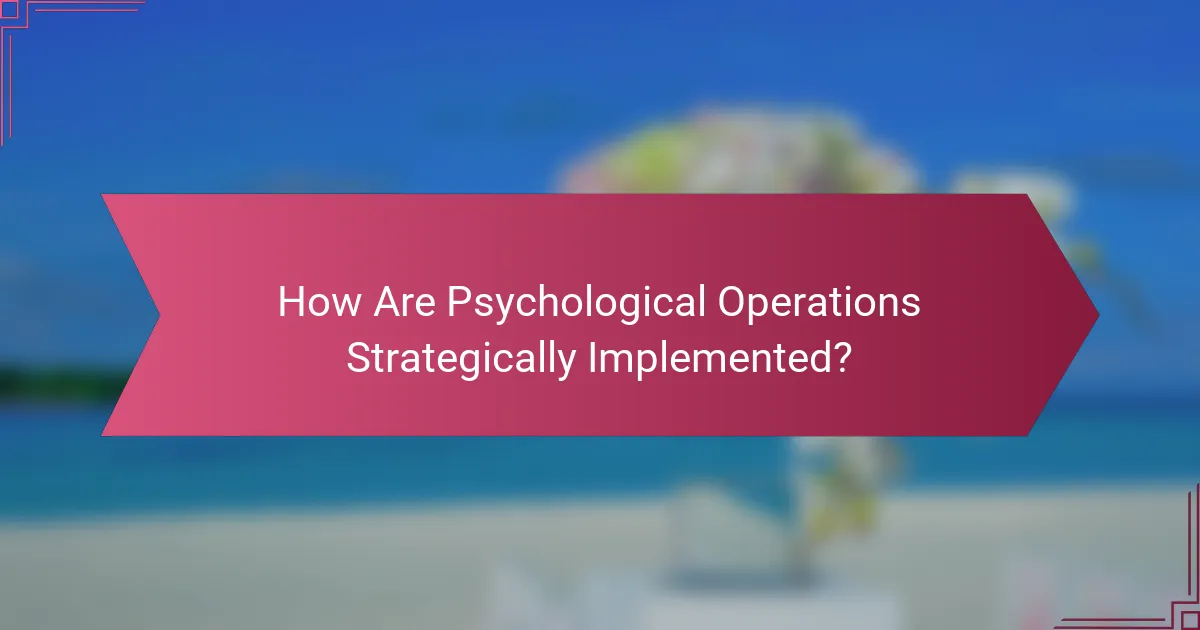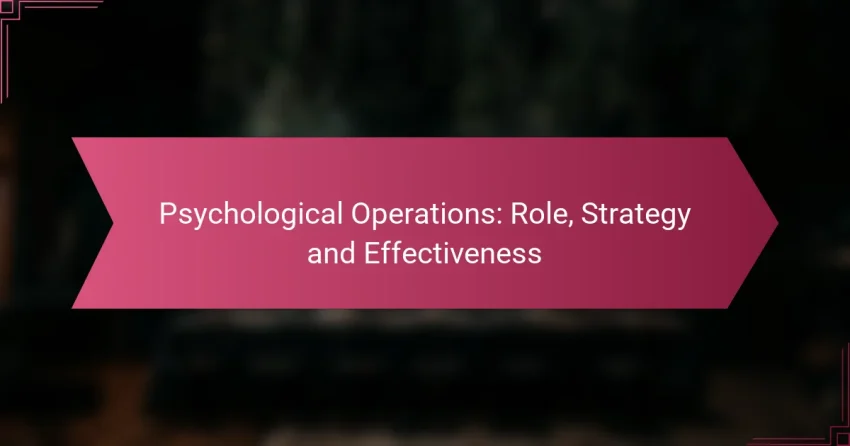Psychological operations (PSYOP) play a crucial role in influencing the attitudes and behaviors of target audiences, shaping public perception, and supporting military and diplomatic objectives. These operations are strategically crafted through a systematic approach that involves understanding the audience, developing tailored messages, and selecting the right channels for delivery. Evaluating the effectiveness of PSYOP is essential, utilizing metrics such as behavioral change assessments and public sentiment analysis to measure their impact and success.

What Are the Key Roles of Psychological Operations?
Psychological operations (PSYOP) are designed to influence the attitudes and behaviors of target audiences. Their key roles include shaping public perception, supporting military objectives, enhancing diplomatic efforts, countering misinformation, and building psychological resilience.
Influencing public perception
Psychological operations aim to shape how the public views certain events, individuals, or organizations. By disseminating targeted messages through various media, PSYOP can create or alter narratives that align with strategic goals.
For instance, during a conflict, PSYOP may promote positive stories about allied forces while undermining the credibility of adversaries. This can be achieved through social media campaigns, press releases, and community outreach programs.
Supporting military objectives
PSYOP plays a crucial role in military strategy by affecting the morale of both enemy and friendly forces. By demoralizing opponents and boosting the confidence of allies, psychological operations can enhance overall mission effectiveness.
For example, leaflets dropped over enemy territory may encourage surrender or highlight the futility of resistance, thereby reducing combat effectiveness without direct confrontation.
Enhancing diplomatic efforts
Psychological operations can strengthen diplomatic initiatives by fostering goodwill and understanding between nations. By promoting positive narratives about a country’s policies or culture, PSYOP can help build alliances and improve international relations.
For instance, cultural exchange programs and public diplomacy campaigns can be used to counter negative stereotypes and enhance a nation’s image abroad.
Countering misinformation
In an age of rapid information dissemination, psychological operations are essential for countering misinformation and disinformation. By providing accurate information and clarifying misconceptions, PSYOP can mitigate the impact of false narratives.
Effective strategies include fact-checking initiatives, public awareness campaigns, and collaboration with social media platforms to flag false content. These efforts help maintain public trust and ensure informed decision-making.
Building psychological resilience
Psychological operations also focus on strengthening the resilience of individuals and communities against adverse influences. By promoting mental health resources and fostering a sense of community, PSYOP can help populations withstand psychological stressors.
Programs may include workshops on critical thinking, media literacy, and stress management techniques. These initiatives empower individuals to recognize and resist manipulative messaging, enhancing overall societal stability.

How Are Psychological Operations Strategically Implemented?
Psychological operations (PSYOP) are strategically implemented through a systematic approach that includes understanding the target audience, crafting effective messages, selecting appropriate channels, and timing the execution. This structured methodology ensures that the operations resonate with the intended audience and achieve desired outcomes.
Target audience analysis
Target audience analysis involves identifying and understanding the specific groups that the psychological operations aim to influence. This includes demographic factors such as age, gender, culture, and socio-economic status, as well as psychological traits like beliefs, values, and motivations.
Effective analysis often employs surveys, focus groups, and data analytics to gather insights. For example, military PSYOP might focus on local populations in conflict zones, requiring a nuanced understanding of their cultural context and grievances.
Message development
Message development is the process of creating content that resonates with the target audience’s emotions and beliefs. This involves crafting clear, persuasive messages that align with the audience’s values and address their concerns.
Messages should be tailored to evoke specific responses, whether it’s fear, hope, or solidarity. For instance, a campaign aimed at reducing support for insurgents might emphasize the benefits of peace and stability, using testimonials from community leaders.
Channel selection
Channel selection refers to choosing the most effective mediums for delivering messages to the target audience. This can include traditional media like television and radio, as well as digital platforms such as social media and websites.
Understanding where the audience consumes information is crucial. For example, younger demographics may be more reachable through social media platforms like Instagram or TikTok, while older audiences might respond better to radio broadcasts or print media.
Timing and execution
Timing and execution are critical in ensuring that psychological operations have the maximum impact. This involves launching campaigns at strategic moments, such as during political events or crises, when the audience is most receptive.
Additionally, continuous monitoring and adaptation are essential. If a message is not resonating as expected, adjustments should be made quickly to improve effectiveness. Utilizing feedback loops can help refine strategies in real-time, enhancing overall success.

What Are the Effectiveness Metrics for Psychological Operations?
The effectiveness metrics for psychological operations (PSYOP) are critical for evaluating their impact and success. Key metrics include behavioral change assessments, public sentiment analysis, and engagement and reach metrics, each providing insights into how well the operations achieve their intended goals.
Behavioral change assessment
Behavioral change assessment measures the extent to which psychological operations influence target audiences’ actions and decisions. This can involve surveys, interviews, or observational studies to gauge shifts in behavior following PSYOP campaigns.
For example, if a PSYOP campaign aims to encourage vaccination in a community, pre- and post-campaign surveys can reveal changes in vaccination rates. Effective assessments often show a correlation between PSYOP efforts and measurable behavioral outcomes.
Public sentiment analysis
Public sentiment analysis evaluates the feelings and attitudes of a population towards specific issues or entities, often using social media and other communication channels. This analysis can help determine how psychological operations shape public perception and opinion.
Tools such as sentiment analysis algorithms can quantify positive, negative, or neutral sentiments expressed online. Regular monitoring can provide insights into how public opinion shifts over time, allowing for adjustments in strategy as needed.
Engagement and reach metrics
Engagement and reach metrics assess how effectively psychological operations connect with their target audience. These metrics include likes, shares, comments, and overall audience reach across various platforms.
For instance, a PSYOP campaign that utilizes social media might track engagement rates to determine which messages resonate most with the audience. High engagement rates often indicate successful messaging, while low rates may signal the need for strategy reevaluation.

What Are the Ethical Considerations in Psychological Operations?
Ethical considerations in psychological operations (PSYOP) focus on the balance between influence and manipulation, ensuring that strategies respect human rights and promote transparency. Practitioners must navigate the fine line between effective communication and deceptive practices, prioritizing accountability in their actions.
Manipulation vs. persuasion
Manipulation involves influencing individuals through deceptive or coercive tactics, while persuasion relies on honest communication and logical reasoning. Ethical PSYOP should prioritize persuasion, fostering trust and understanding rather than exploiting vulnerabilities. For example, a campaign that informs citizens about health risks uses persuasion, whereas one that spreads misinformation for compliance leans towards manipulation.
To maintain ethical integrity, practitioners should assess their methods regularly. They can ask themselves if their strategies respect the autonomy of the audience and whether the intended outcomes serve the greater good. Avoiding manipulation not only builds credibility but also enhances the long-term effectiveness of PSYOP initiatives.
Transparency and accountability
Transparency in psychological operations means openly communicating the intent and methods used in campaigns. This approach fosters trust among the target audience and mitigates the risk of backlash. For instance, when governments engage in PSYOP during public health crises, clear communication about the objectives and methods can enhance public cooperation.
Accountability involves being responsible for the outcomes of PSYOP efforts. Practitioners should establish clear guidelines and ethical standards, ensuring that their actions can be scrutinized. Regular evaluations and feedback mechanisms can help organizations assess the impact of their operations and make necessary adjustments to uphold ethical standards.

How Do Psychological Operations Differ by Region?
Psychological operations (PSYOP) vary significantly by region due to cultural, political, and social factors. Understanding these differences is crucial for effectively implementing strategies tailored to specific audiences.
North America
In North America, psychological operations often focus on information dissemination through digital platforms and social media. The emphasis is on shaping public opinion and influencing political discourse, particularly during elections. Campaigns may utilize targeted advertising and data analytics to reach specific demographics.
Common tactics include leveraging influencers and creating emotionally resonant content. For example, a campaign might use social media to promote civic engagement or counter misinformation during critical events.
Europe
European psychological operations are influenced by diverse languages and cultural backgrounds. Strategies often involve collaboration among EU member states to address issues like disinformation and extremism. The use of multilingual messaging is essential to ensure clarity and relevance across different populations.
For instance, during the refugee crisis, PSYOP aimed to foster understanding and acceptance through campaigns that highlighted personal stories and positive contributions of migrants. This approach sought to mitigate xenophobia and promote social cohesion.
Asia
In Asia, psychological operations are frequently shaped by historical contexts and regional conflicts. Nations may employ PSYOP to bolster national unity or counter external threats. Messaging often reflects local values and norms, making cultural sensitivity paramount.
For example, in countries with strong collectivist cultures, campaigns might emphasize community well-being and shared goals. This can be seen in public health initiatives that encourage vaccination through appeals to social responsibility.
Africa
African psychological operations often focus on addressing socio-economic challenges and promoting stability. Strategies may include grassroots campaigns that engage local leaders and communities to foster trust and cooperation. The use of radio and community gatherings is common due to varying levels of access to technology.
For instance, during elections, PSYOP might involve mobilizing communities to participate in the democratic process by highlighting the importance of voting and civic engagement. Tailoring messages to resonate with local traditions enhances effectiveness.
Latin America
In Latin America, psychological operations frequently address issues of governance, corruption, and social justice. Campaigns may aim to empower citizens and promote accountability through awareness-raising initiatives. The use of storytelling and visual media is prevalent to connect emotionally with audiences.
For example, anti-corruption campaigns often utilize social media to share impactful narratives of change, encouraging public participation in governance. Engaging local influencers can amplify these messages and foster community involvement.
